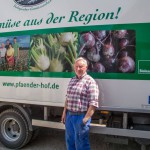Farm description
An important issue for Mr. Pfänder is the concept of a largely closed farm cycle especially with regard of his own farm having many intensive vegetable crops but no animal husbandry. A conscious decision for vegetarism of the whole family is an important foundation for running the farm. This forms the basis for the renunciation of farm animals as well as animal manure (except some minor amounts of horse dung from neighboring farms).
The since 1998 cattleless running Bioland farm Pfänderhof is located at 560 m above sea level and has, with an average annual temperature of 7,6⁰C a mean annual rainfall of 700-800 mm. On nearly 60 ha loess clay soils and alluvial soils field vegetables, clover grass, cereals (54 ha) are grown. Additionally, structural landscape hedges and forests (1.5 ha) and permanent grassland (3 ha) are part of the farm.
Climate friendly practices applied
- Improved on-farm nutrient management
Composting of on-farm residues
All on-farm residues are composted. Fresh piles consist of biomass of forage legumes, waste from vegetable processing, straw, soil from carrot washing. The compost is regularly turned and used as a fertilizer for all fields. Therefore, this helps to close on-farm nutrient cycles.
Composting green manure helps to reduce CH4 and N2O emissions, compared to the emissions of a residue pile. Additionally, compost application helps to reduce fertilizer application in the following years.
- Optimised crop rotations with legumes
The farm introduced leguminous crops at 25% of the total arable land. Before cultivating green manure leys, broad beans, field peas and soy beans, they cultivated maize on 13 ha.
Legume crops contribute to N fixation and therefore reduce the amount of fertilizers needed in the following years.
- Optimised tillage systems
Reduced tillage and undersown crops
The Pfänder farm tested a no-tillage approach for some crop cultures (winter wheat, oats, spelt, clover and green manure) with a total area of 19 ha. Before SOLMACC, these cultures were tilled annually with a depth of 15-25 cm.
Reducing tillage helps to reduce fossil fuel consumption.
- Agroforestry
Hedgerows and tree strips along agricultural fields
The Pfänder family planted hedges and tree strips (0.61 ha) and cultivates around 1 ha forest. Part of the forest wood is used to substitute fossil fuel house heating.
Trees and hedges help to sequester atmospheric carbon into plant biomass and soils. Therefore, they function as a carbon sink.
Location
Other farms
